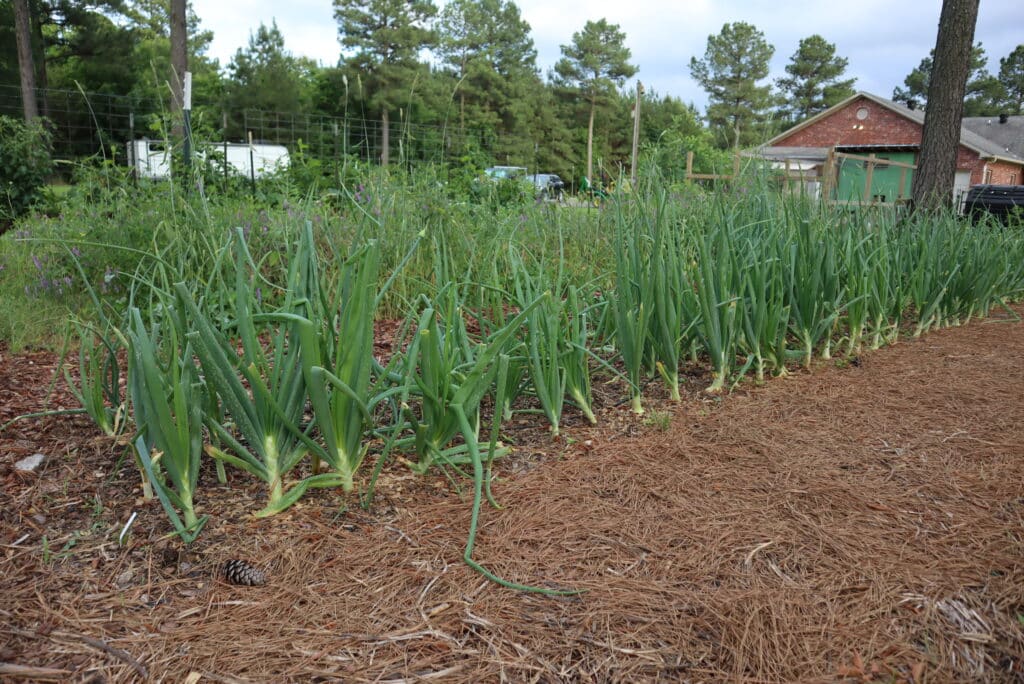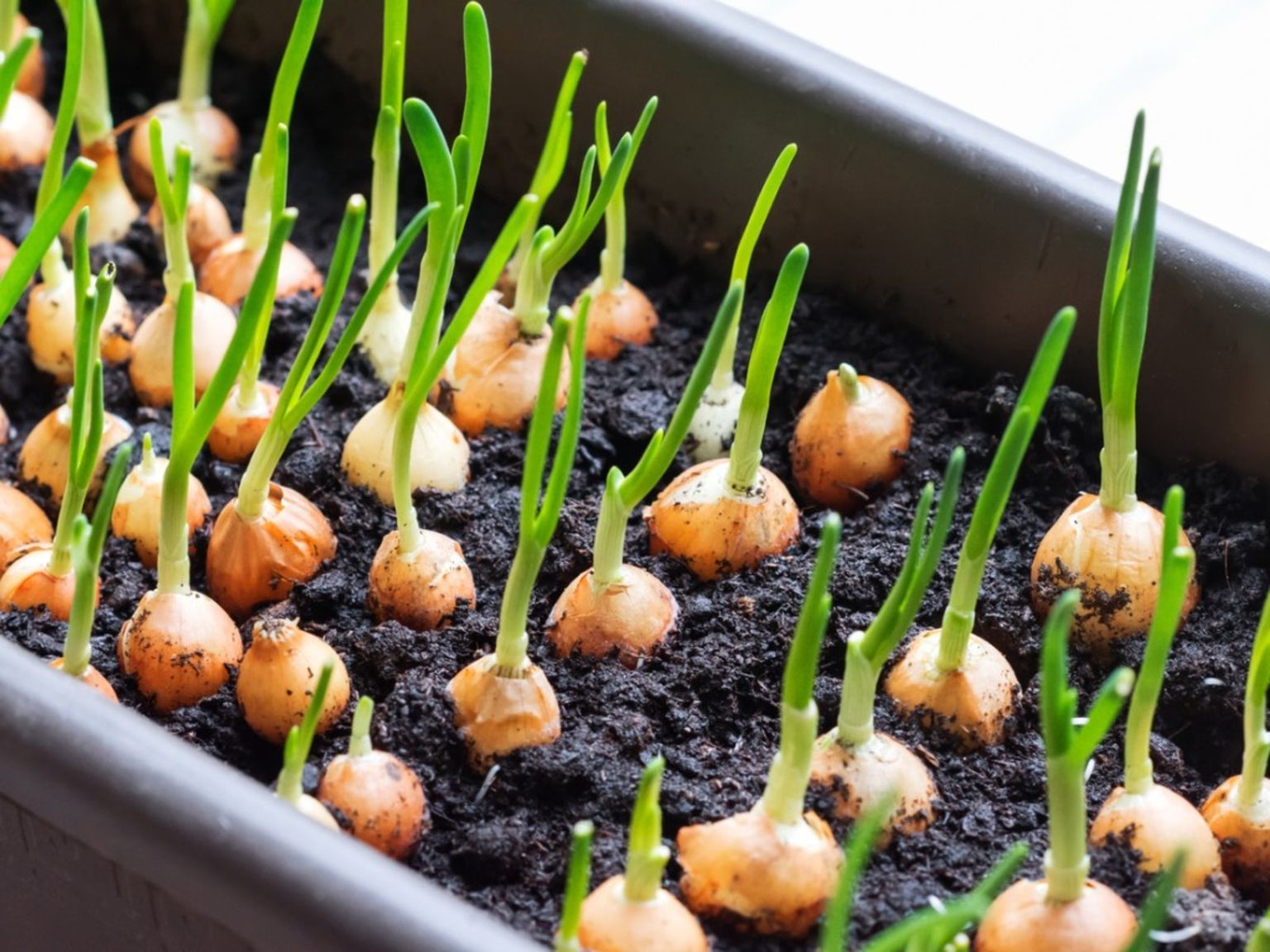We think that when we grow onions for bulbs, we will get a bunch of big, round bulbs. And, if we have more than we need fresh, we hope to store them for months.
But what should you do when the top of your onion plants starts to form a white teardrop-shaped tip? This is not what we want because it means the onion has bolted.
When an onion starts to bolt, that tear-drop tip will continue to grow taller than the other leaves. This stem is actually a young flower stalk. If you leave the flower alone, it will bring pollinators to your garden. However, the onion bulb has stopped growing because the plant has switched from making bulbs to making seeds. Not only that, but the onion has also lost its ability to store long-term.
While no onion grower wants to see this, you have options if it happens to you. There are also a few things you can do to prevent it from happening next year. Let’s talk about that.
Seeing your lovingly tended onion plants shoot up a flower stalk can be disheartening for any gardener. This process known as “bolting” turns your prospective big bulbs into disappointing greens destined for the compost heap. But bolting doesn’t have to spell disaster for your onion patch. Read on to understand why onions bolt, what it means for your crop, and most importantly, what you can do about it!
What Is Bolting and Why Do Onions Bolt?
Onions and other alliums like garlic and shallots are biennial plants, meaning they take two years to complete their lifecycle. The first year they grow foliage and swell their underground bulb, storing energy for the next phase. The second year, they use that reserved energy to rapidly shoot up a tall central stalk and produce flowers, seeds, and then die back.
This is all part of the natural lifecycle. However, when onions “bolt” prematurely in the first year, it means something triggered the early formation of that flower stalk. This diverts energy away from bulb growth, resulting in stunted onions.
Onions bolt in response to stress, which causes a survival mechanism to kick in and skip to the reproduction phase Key stressors include
- Temperature extremes – prolonged cold or sudden heat waves
- Drastic temperature swings – warm days and cold nights
- Lack of water during hot, dry periods
- Excess moisture from heavy rains, irrigation, or over-wet soil
- Damage to the bulb and roots from cultivation, transplanting, or pest attacks
- Excess nitrogen fertilization later in the season
What To Do With Bolting Onions
When you spot an onion plant shooting up a developing flower stalk, take these steps:
-
Remove the stalk. Cut or snap off the stalk at ground level. This won’t restart bulb growth, but it stops further energy drain.
-
Harvest ASAP. Use, preserve, or process the onions right away. Bolted onions won’t size up anymore or store well.
-
Leave some stalks. Allow a few bolted onions to fully flower and set seed. Collect these for planting next year.
-
Chop and freeze. Diced onions freeze nicely for later cooking use.
-
Dehydrate. Dried onion slices or powder are great pantry staples.
-
Freeze dry. Freeze dried onions retain excellent texture and flavor for soups, stews, etc.
Preventing Onions From Bolting
While you can’t control the weather, using good cultural practices can help minimize bolting:
-
Choose adapted varieties. Pick long day, short day or intermediate onions suited to your climate.
-
Use seeds or transplants. Sets (small bulbs) are prone to bolt, especially in hot areas.
-
Time planting carefully. Follow local guides for best windows to plant fall or spring onions.
-
Water consistently. Ensure onions get 1-2 inches of water per week, more in extreme heat.
-
Avoid damaging plants. Be gentle when weeding, hilling and cultivating around onions.
-
Go easy on nitrogen. Reduce high-nitrogen fertilizers when bulbing begins.
-
Monitor for pests. Prevent damage from onion flies, maggots, nematodes, etc.
-
Cover with soil. Hill up soil or mulch around the bulbs to protect from sunscald.
When Bolting Spoils Your Onion Harvest
Even if you do everything right, some onions may still bolt, especially during periods of abnormal weather. While disappointing, bolting doesn’t have to mean a total loss. Adjust your plans, use the greens, and preserve the bulbs for later use in your kitchen. Taking notes on which varieties did best can guide future plant choices too.
Most importantly, don’t let a bolting year discourage you from growing onions again. Collect some seeds and start planning next season’s onion crop wiser and better equipped to avoid potential pitfalls. With a few lessons learned, you’ll be back on track to big, beautiful bulbs once again.
Compare Where You Grow Your Onions
Second, you can compare growing your onions in raised beds, ground beds and containers. This is a test to see if there is one growing condition that works better for you.
For example, the soil in raised beds is more sensitive to weather changes than ground beds. This may lead to soil temperature fluctuations that can be more significant than in the ground soil. If it rains a lot in the spring, planting onions in a soggy ground bed can kill the plants. On the other hand, planting onions in raised beds lets the water drain better.
These examples are meant to get you to test things on your own if you can plant in raised beds, ground beds, or containers. One option may end up preventing bolting more than another.

How to Avoid It For Next Season
This is why onions bolt in the first place. Now we can talk about how to stop them from bolting.
Onions bolt due to some sort of stress. There are several different reasons why that could happen but most of the time it is weather induced. Onions are a biennial plant meaning that normally, they would flower the second year in their life cycle. If the weather changes a lot during one season, with hot and cold spells, the plants may think it’s time to set seeds because it’s been two years already. Even though you can’t stop the weather from changing, there are a few things you can do to slow down the bolting.
First, you can plant different varieties and take note of the rate at which each one bolts. Some types of plants can handle changes in weather better than others. If you see that fewer plants of one type bolted this year, plan to plant more of that type next year.
I’ve noticed this year that my Red Creole variety has bolted more than Patterson or Candy onions. If you live where I do and can grow both short day and intermediate day onions (read more about how to choose the right day length onion here), try planting a mix of the two. I have noticed that my intermediate day onions bolt less than short day. As before, you can only learn from your own garden and what works and what doesn’t.
This Transplanting Method for Onions Is a GAME CHANGER
FAQ
What do you do when your onions go to seed?
Should you remove onion scapes?
What are the symptoms of bolting in onions?
- The Ultimate Guide to Growing Strawberries in Raised Beds - August 8, 2025
- No-Dig Garden Beds: The Easiest Way to Grow a Beautiful Garden - August 6, 2025
- How to Protect and Preserve Wood for Raised Garden Beds - August 6, 2025

